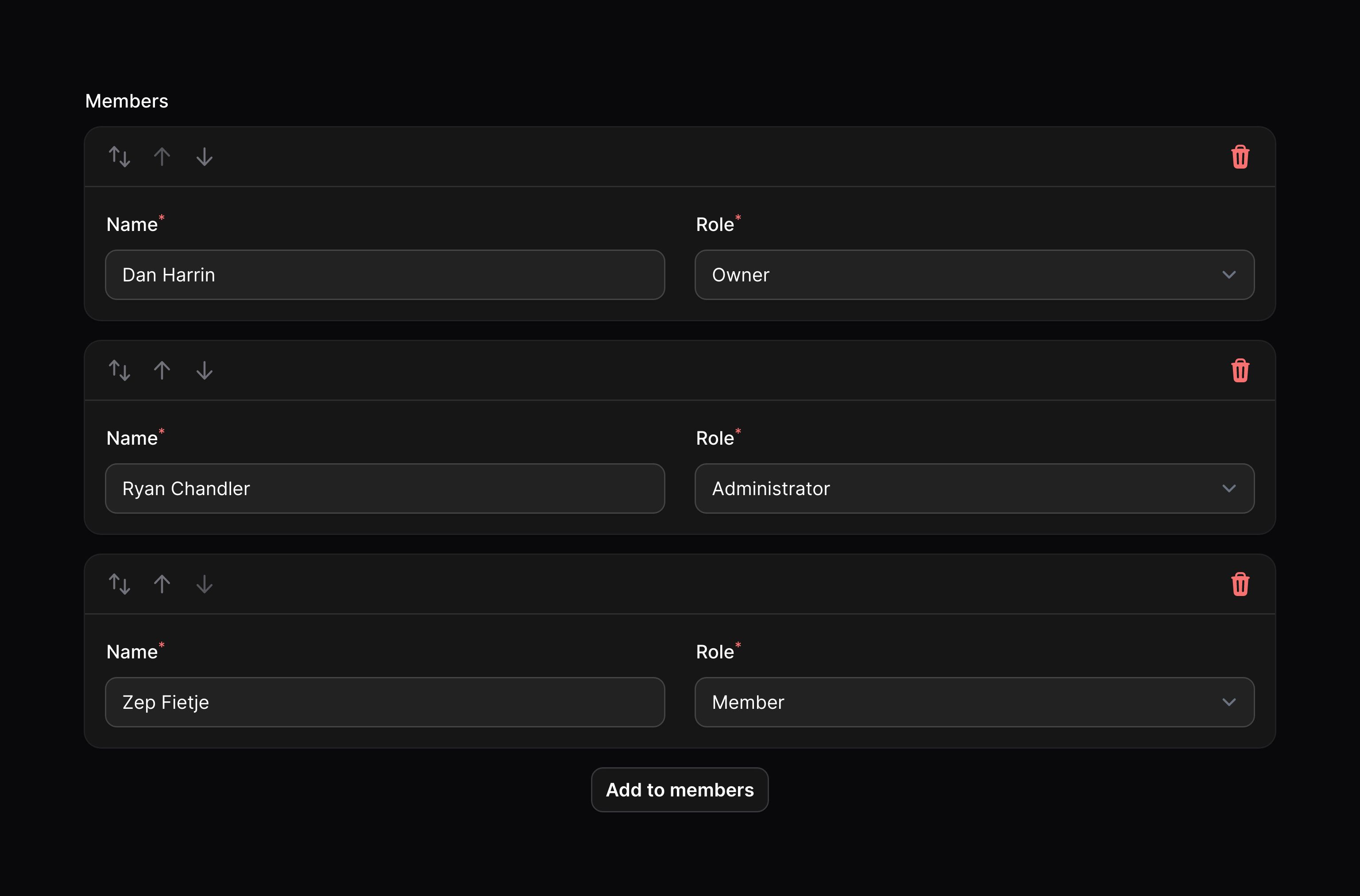Form Builder - Fields
Repeater
Overview
The repeater component allows you to output a JSON array of repeated form components.
use Filament\Forms\Components\Repeater;use Filament\Forms\Components\Select;use Filament\Forms\Components\TextInput; Repeater::make('members') ->schema([ TextInput::make('name')->required(), Select::make('role') ->options([ 'member' => 'Member', 'administrator' => 'Administrator', 'owner' => 'Owner', ]) ->required(), ]) ->columns(2)
We recommend that you store repeater data with a JSON column in your database. Additionally, if you're using Eloquent, make sure that column has an array cast.
As evident in the above example, the component schema can be defined within the schema() method of the component:
use Filament\Forms\Components\Repeater;use Filament\Forms\Components\TextInput; Repeater::make('members') ->schema([ TextInput::make('name')->required(), // ... ])If you wish to define a repeater with multiple schema blocks that can be repeated in any order, please use the builder.
Setting empty default items
Repeaters may have a certain number of empty items created by default, using the defaultItems() method:
use Filament\Forms\Components\Repeater; Repeater::make('members') ->schema([ // ... ]) ->defaultItems(3)Note that these default items are only created when the form is loaded without existing data. Inside panel resources this only works on Create Pages, as Edit Pages will always fill the data from the model.
Adding items
An action button is displayed below the repeater to allow the user to add a new item.
Setting the add action button's label
You may set a label to customize the text that should be displayed in the button for adding a repeater item, using the addActionLabel() method:
use Filament\Forms\Components\Repeater; Repeater::make('members') ->schema([ // ... ]) ->addActionLabel('Add member')Preventing the user from adding items
You may prevent the user from adding items to the repeater using the addable(false) method:
use Filament\Forms\Components\Repeater; Repeater::make('members') ->schema([ // ... ]) ->addable(false)Deleting items
An action button is displayed on each item to allow the user to delete it.
Preventing the user from deleting items
You may prevent the user from deleting items from the repeater using the deletable(false) method:
use Filament\Forms\Components\Repeater; Repeater::make('members') ->schema([ // ... ]) ->deletable(false)Reordering items
A button is displayed on each item to allow the user to drag and drop to reorder it in the list.
Preventing the user from reordering items
You may prevent the user from reordering items from the repeater using the reorderable(false) method:
use Filament\Forms\Components\Repeater; Repeater::make('members') ->schema([ // ... ]) ->reorderable(false)Reordering items with buttons
You may use the reorderableWithButtons() method to enable reordering items with buttons to move the item up and down:
use Filament\Forms\Components\Repeater; Repeater::make('members') ->schema([ // ... ]) ->reorderableWithButtons()
Preventing reordering with drag and drop
You may use the reorderableWithDragAndDrop(false) method to prevent items from being ordered with drag and drop:
use Filament\Forms\Components\Repeater; Repeater::make('members') ->schema([ // ... ]) ->reorderableWithDragAndDrop(false)Collapsing items
The repeater may be collapsible() to optionally hide content in long forms:
use Filament\Forms\Components\Repeater; Repeater::make('qualifications') ->schema([ // ... ]) ->collapsible()You may also collapse all items by default:
use Filament\Forms\Components\Repeater; Repeater::make('qualifications') ->schema([ // ... ]) ->collapsed()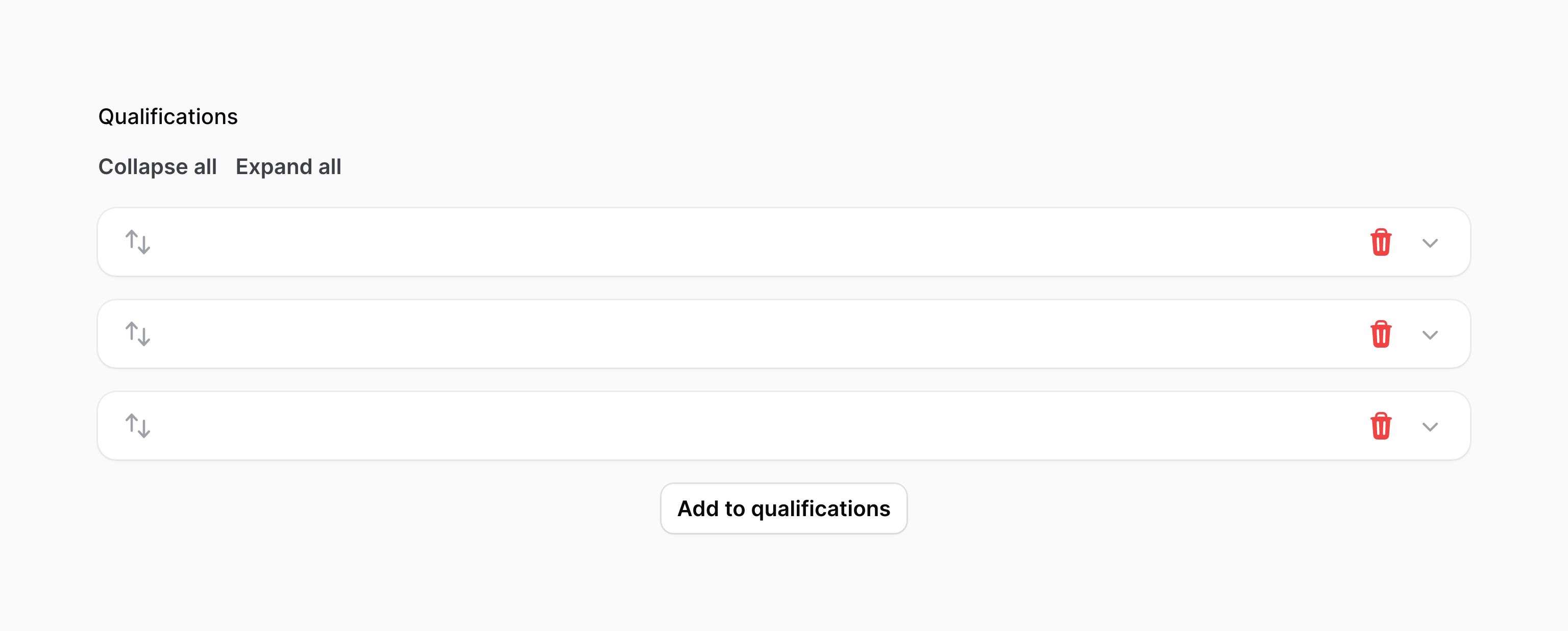
Cloning items
You may allow repeater items to be duplicated using the cloneable() method:
use Filament\Forms\Components\Repeater; Repeater::make('qualifications') ->schema([ // ... ]) ->cloneable()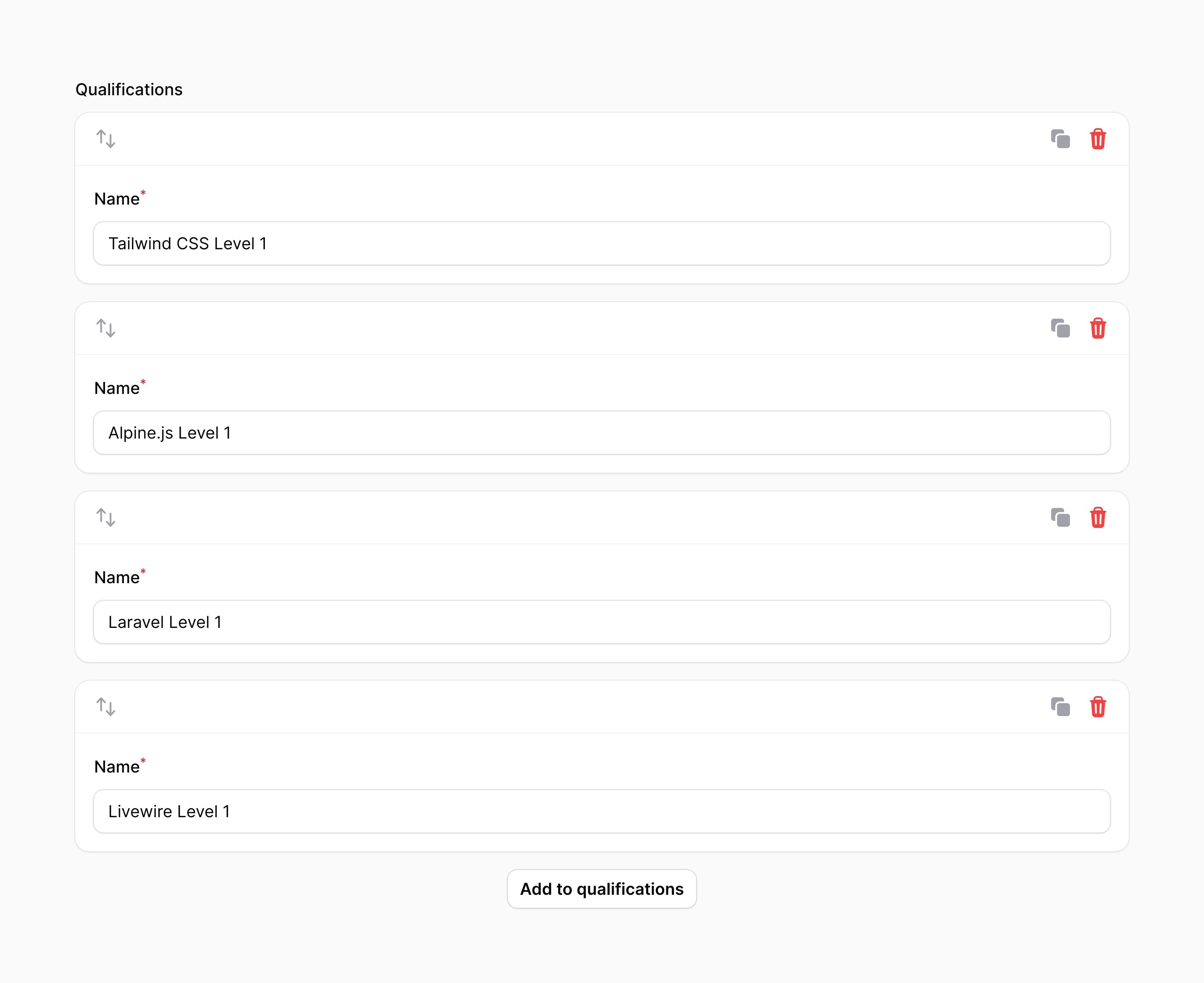
Integrating with an Eloquent relationship
If you're building a form inside your Livewire component, make sure you have set up the form's model. Otherwise, Filament doesn't know which model to use to retrieve the relationship from.
You may employ the relationship() method of the Repeater to configure a HasMany relationship. Filament will load the item data from the relationship, and save it back to the relationship when the form is submitted. If a custom relationship name is not passed to relationship(), Filament will use the field name as the relationship name:
use Filament\Forms\Components\Repeater; Repeater::make('qualifications') ->relationship() ->schema([ // ... ])When using disabled() with relationship(), ensure that disabled() is called before relationship(). This ensures that the dehydrated() call from within relationship() is not overridden by the call from disabled():
use Filament\Forms\Components\Repeater; Repeater::make('qualifications') ->disabled() ->relationship() ->schema([ // ... ])Reordering items in a relationship
By default, reordering relationship repeater items is disabled. This is because your related model needs a sort column to store the order of related records. To enable reordering, you may use the orderColumn() method, passing in a name of the column on your related model to store the order in:
use Filament\Forms\Components\Repeater; Repeater::make('qualifications') ->relationship() ->schema([ // ... ]) ->orderColumn('sort')If you use something like spatie/eloquent-sortable with an order column such as order_column, you may pass this in to orderColumn():
use Filament\Forms\Components\Repeater; Repeater::make('qualifications') ->relationship() ->schema([ // ... ]) ->orderColumn('order_column')Integrating with a BelongsToMany Eloquent relationship
There is a common misconception that using a BelongsToMany relationship with a repeater is as simple as using a HasMany relationship. This is not the case, as a BelongsToMany relationship requires a pivot table to store the relationship data. The repeater saves its data to the related model, not the pivot table. Therefore, if you want to map each repeater item to a row in the pivot table, you must use a HasMany relationship with a pivot model to use a repeater with a BelongsToMany relationship.
Imagine you have a form to create a new Order model. Each order belongs to many Product models, and each product belongs to many orders. You have a order_product pivot table to store the relationship data. Instead of using the products relationship with the repeater, you should create a new relationship called orderProducts on the Order model, and use that with the repeater:
use Illuminate\Database\Eloquent\Relations\HasMany; public function orderProducts(): HasMany{ return $this->hasMany(OrderProduct::class);}If you don't already have an OrderProduct pivot model, you should create that, with inverse relationships to Order and Product:
use Illuminate\Database\Eloquent\Relations\BelongsTo;use Illuminate\Database\Eloquent\Relations\Pivot; class OrderProduct extends Pivot{ public function order(): BelongsTo { return $this->belongsTo(Order::class); } public function product(): BelongsTo { return $this->belongsTo(Product::class); }}Please ensure that your pivot model has a primary key column, like
id, to allow Filament to keep track of which repeater items have been created, updated and deleted.
Now you can use the orderProducts relationship with the repeater, and it will save the data to the order_product pivot table:
use Filament\Forms\Components\Repeater;use Filament\Forms\Components\Select; Repeater::make('orderProducts') ->relationship() ->schema([ Select::make('product_id') ->relationship('product', 'name') ->required(), // ... ])Mutating related item data before filling the field
You may mutate the data for a related item before it is filled into the field using the mutateRelationshipDataBeforeFillUsing() method. This method accepts a closure that receives the current item's data in a $data variable. You must return the modified array of data:
use Filament\Forms\Components\Repeater; Repeater::make('qualifications') ->relationship() ->schema([ // ... ]) ->mutateRelationshipDataBeforeFillUsing(function (array $data): array { $data['user_id'] = auth()->id(); return $data; })Mutating related item data before creating
You may mutate the data for a new related item before it is created in the database using the mutateRelationshipDataBeforeCreateUsing() method. This method accepts a closure that receives the current item's data in a $data variable. You can choose to return either the modified array of data, or null to prevent the item from being created:
use Filament\Forms\Components\Repeater; Repeater::make('qualifications') ->relationship() ->schema([ // ... ]) ->mutateRelationshipDataBeforeCreateUsing(function (array $data): array { $data['user_id'] = auth()->id(); return $data; })Mutating related item data before saving
You may mutate the data for an existing related item before it is saved in the database using the mutateRelationshipDataBeforeSaveUsing() method. This method accepts a closure that receives the current item's data in a $data variable. You can choose to return either the modified array of data, or null to prevent the item from being saved:
use Filament\Forms\Components\Repeater; Repeater::make('qualifications') ->relationship() ->schema([ // ... ]) ->mutateRelationshipDataBeforeSaveUsing(function (array $data): array { $data['user_id'] = auth()->id(); return $data; })Grid layout
You may organize repeater items into columns by using the grid() method:
use Filament\Forms\Components\Repeater; Repeater::make('qualifications') ->schema([ // ... ]) ->grid(2)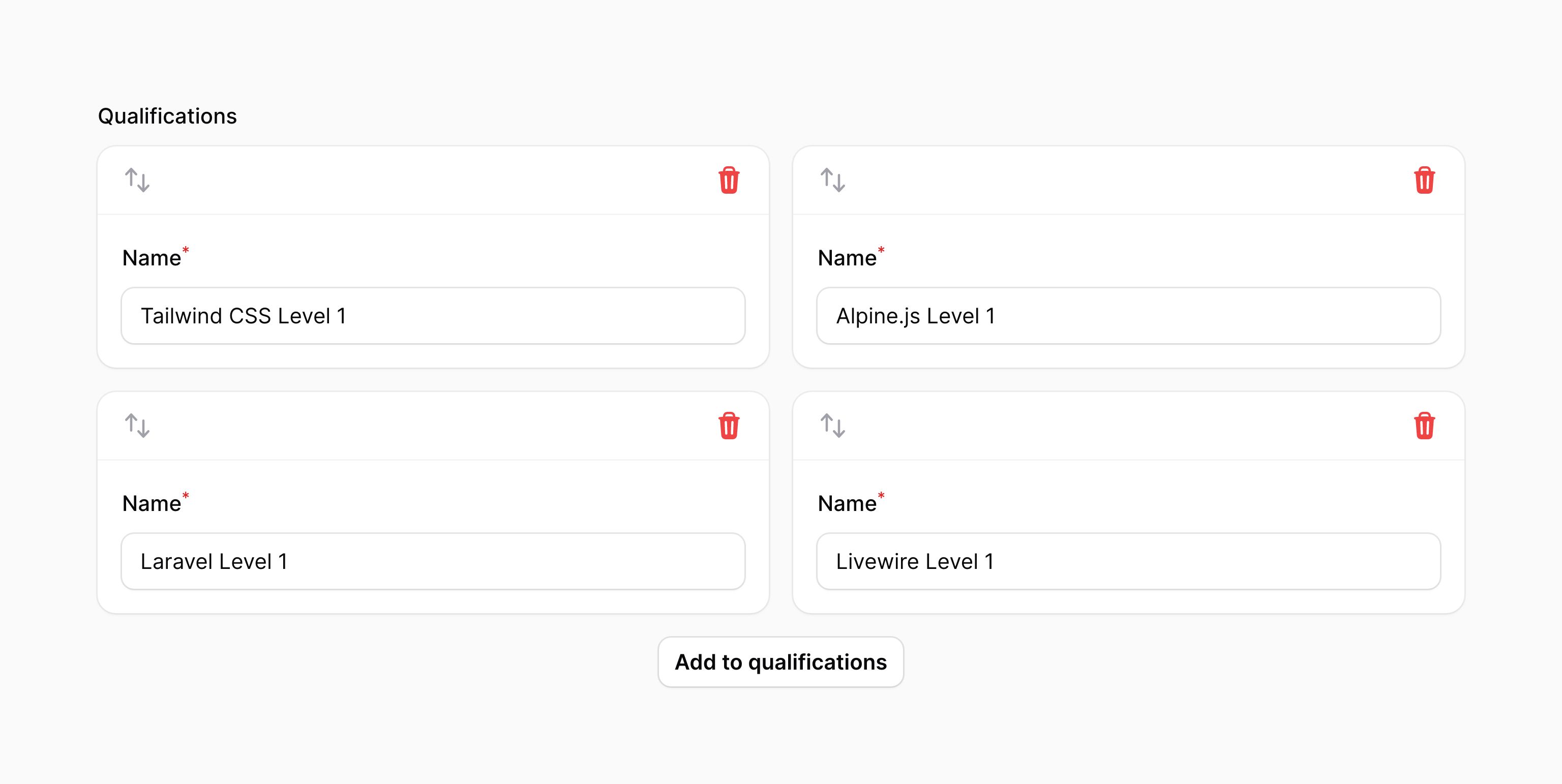
This method accepts the same options as the columns() method of the grid. This allows you to responsively customize the number of grid columns at various breakpoints.
Adding a label to repeater items based on their content
You may add a label for repeater items using the itemLabel() method. This method accepts a closure that receives the current item's data in a $state variable. You must return a string to be used as the item label:
use Filament\Forms\Components\Repeater;use Filament\Forms\Components\TextInput;use Filament\Forms\Components\Select; Repeater::make('members') ->schema([ TextInput::make('name') ->required() ->live(onBlur: true), Select::make('role') ->options([ 'member' => 'Member', 'administrator' => 'Administrator', 'owner' => 'Owner', ]) ->required(), ]) ->columns(2) ->itemLabel(fn (array $state): ?string => $state['name'] ?? null),Any fields that you use from $state should be live() if you wish to see the item label update live as you use the form.
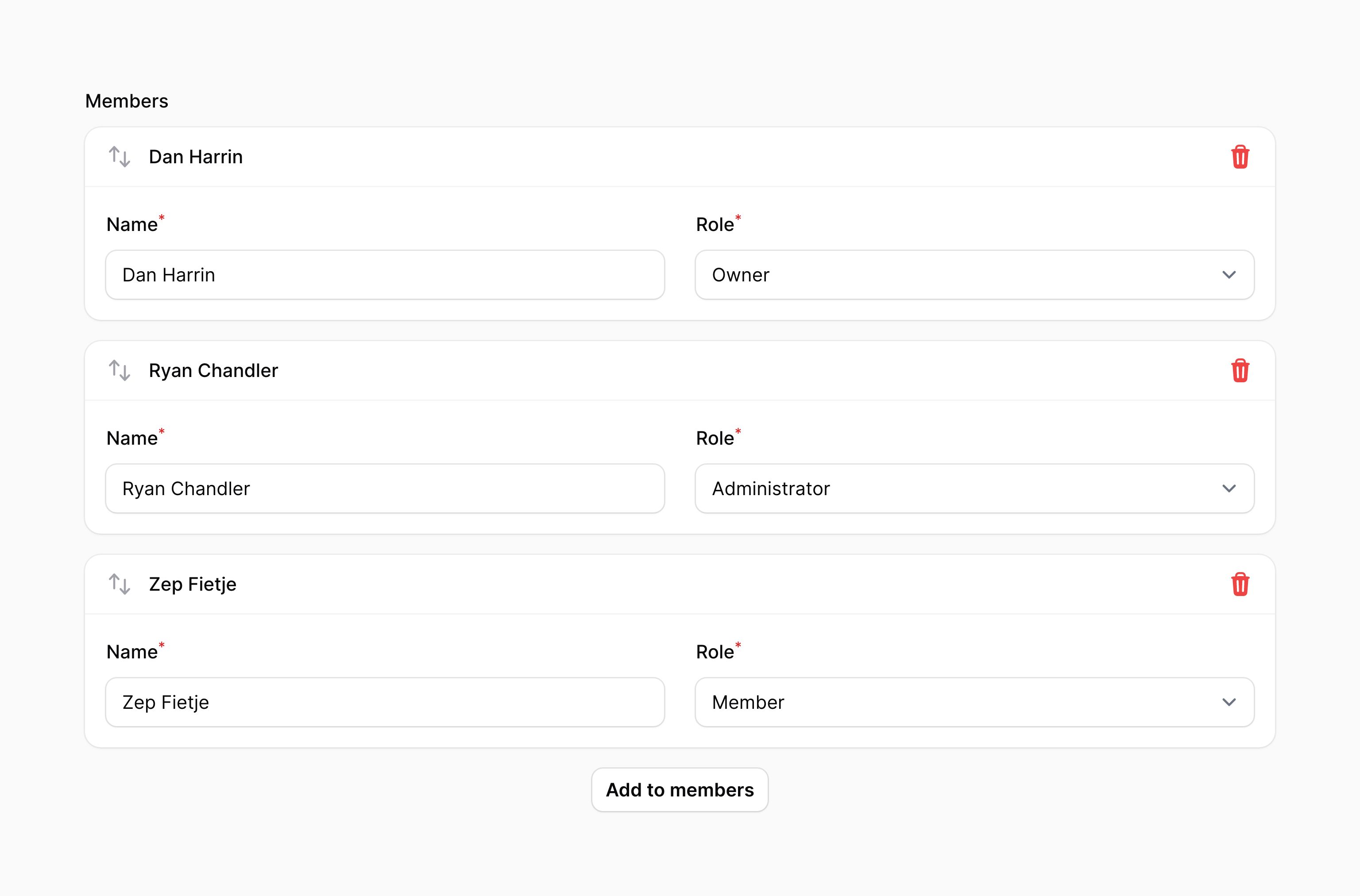
Simple repeaters with one field
You can use the simple() method to create a repeater with a single field, using a minimal design
use Filament\Forms\Components\Repeater;use Filament\Forms\Components\TextInput; Repeater::make('invitations') ->simple( TextInput::make('email') ->email() ->required(), )
Instead of using a nested array to store data, simple repeaters use a flat array of values. This means that the data structure for the above example could look like this:
[ 'invitations' => [ ],],Using $get() to access parent field values
All form components are able to use $get() and $set() to access another field's value. However, you might experience unexpected behaviour when using this inside the repeater's schema.
This is because $get() and $set(), by default, are scoped to the current repeater item. This means that you are able to interact with another field inside that repeater item easily without knowing which repeater item the current form component belongs to.
The consequence of this is that you may be confused when you are unable to interact with a field outside the repeater. We use ../ syntax to solve this problem - $get('../../parent_field_name').
Consider your form has this data structure:
[ 'client_id' => 1, 'repeater' => [ 'item1' => [ 'service_id' => 2, ], ],]You are trying to retrieve the value of client_id from inside the repeater item.
$get() is relative to the current repeater item, so $get('client_id') is looking for $get('repeater.item1.client_id').
You can use ../ to go up a level in the data structure, so $get('../client_id') is $get('repeater.client_id') and $get('../../client_id') is $get('client_id').
Repeater validation
As well as all rules listed on the validation page, there are additional rules that are specific to repeaters.
Number of items validation
You can validate the minimum and maximum number of items that you can have in a repeater by setting the minItems() and maxItems() methods:
use Filament\Forms\Components\Repeater; Repeater::make('members') ->schema([ // ... ]) ->minItems(2) ->maxItems(5)Distinct state validation
In many cases, you will want to ensure some sort of uniqueness between repeater items. A couple of common examples could be:
- Ensuring that only one checkbox or toggle is activated at once across items in the repeater.
- Ensuring that an option may only be selected once across select, radio, checkbox list, or toggle buttons fields in a repeater.
You can use the distinct() method to validate that the state of a field is unique across all items in the repeater:
use Filament\Forms\Components\Checkbox;use Filament\Forms\Components\Repeater; Repeater::make('answers') ->schema([ // ... Checkbox::make('is_correct') ->distinct(), ])The behaviour of the distinct() validation depends on the data type that the field handles
- If the field returns a boolean, like a checkbox or toggle, the validation will ensure that only one item has a value of
true. There may be many fields in the repeater that have a value offalse. - Otherwise, for fields like a select, radio, checkbox list, or toggle buttons, the validation will ensure that each option may only be selected once across all items in the repeater.
Automatically fixing indistinct state
If you'd like to automatically fix indistinct state, you can use the fixIndistinctState() method:
use Filament\Forms\Components\Checkbox;use Filament\Forms\Components\Repeater; Repeater::make('answers') ->schema([ // ... Checkbox::make('is_correct') ->fixIndistinctState(), ])This method will automatically enable the distinct() and live() methods on the field.
Depending on the data type that the field handles, the behaviour of the fixIndistinctState() adapts:
- If the field returns a boolean, like a checkbox or toggle, and one of the fields is enabled, Filament will automatically disable all other enabled fields on behalf of the user.
- Otherwise, for fields like a select, radio, checkbox list, or toggle buttons, when a user selects an option, Filament will automatically deselect all other usages of that option on behalf of the user.
Disabling options when they are already selected in another item
If you'd like to disable options in a select, radio, checkbox list, or toggle buttons when they are already selected in another item, you can use the disableOptionsWhenSelectedInSiblingRepeaterItems() method:
use Filament\Forms\Components\Repeater;use Filament\Forms\Components\Select; Repeater::make('members') ->schema([ Select::make('role') ->options([ // ... ]) ->disableOptionsWhenSelectedInSiblingRepeaterItems(), ])This method will automatically enable the distinct() and live() methods on the field.
Customizing the repeater item actions
This field uses action objects for easy customization of buttons within it. You can customize these buttons by passing a function to an action registration method. The function has access to the $action object, which you can use to customize it. The following methods are available to customize the actions:
addAction()cloneAction()collapseAction()collapseAllAction()deleteAction()expandAction()expandAllAction()moveDownAction()moveUpAction()reorderAction()
Here is an example of how you might customize an action:
use Filament\Forms\Components\Actions\Action;use Filament\Forms\Components\Repeater; Repeater::make('members') ->schema([ // ... ]) ->collapseAllAction( fn (Action $action) => $action->label('Collapse all members'), )Confirming repeater actions with a modal
You can confirm actions with a modal by using the requiresConfirmation() method on the action object. You may use any modal customization method to change its content and behaviour:
use Filament\Forms\Components\Actions\Action;use Filament\Forms\Components\Repeater; Repeater::make('members') ->schema([ // ... ]) ->deleteAction( fn (Action $action) => $action->requiresConfirmation(), )The
collapseAction(),collapseAllAction(),expandAction(),expandAllAction()andreorderAction()methods do not support confirmation modals, as clicking their buttons does not make the network request that is required to show the modal.
Adding extra item actions to a repeater
You may add new action buttons to the header of each repeater item by passing Action objects into extraItemActions():
use Filament\Forms\Components\Actions\Action;use Filament\Forms\Components\Repeater;use Filament\Forms\Components\TextInput;use Illuminate\Support\Facades\Mail; Repeater::make('members') ->schema([ TextInput::make('email') ->label('Email address') ->email(), // ... ]) ->extraItemActions([ Action::make('sendEmail') ->icon('heroicon-m-envelope') ->action(function (array $arguments, Repeater $component): void { $itemData = $component->getItemState($arguments['item']); Mail::to($itemData['email']) ->send( // ... ); }), ])In this example, $arguments['item'] gives you the ID of the current repeater item. You can validate the data in that repeater item using the getItemState() method on the repeater component. This method returns the validated data for the item. If the item is not valid, it will cancel the action and show an error message for that item in the form.
If you want to get the raw data from the current item without validating it, you can use $component->getRawItemState($arguments['item']) instead.
If you want to manipulate the raw data for the entire repeater, for example, to add, remove or modify items, you can use $component->getState() to get the data, and $component->state($state) to set it again:
use Illuminate\Support\Str; // Get the raw data for the entire repeater$state = $component->getState(); // Add an item, with a random UUID as the key$state[Str::uuid()] = [ 'email' => auth()->user()->email,]; // Set the new data for the repeater$component->state($state);Still need help? Join our Discord community or open a GitHub discussion


